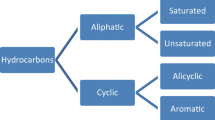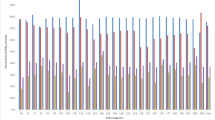Abstract
The objective of the present paper was to investigate the potential of urban wastes derived soluble bioorganic substances (SBO) to perform as auxiliaries for enhanced washing of urban soil contaminated by industrial activities. The second objective was to show how the SBO could be used for remediating the environmental impact caused by industrial activities and, at the same time, be compatible with the real-world situation demanding zero waste processes. The SBO, isolated from four urban biowastes, were characterized for their lipophilic/hydrophilic (LH) and aliphatic/aromatic C ratios, and for their surface activity properties. Soil, containing about 0.45 % w/w polycyclic aromatic hydrocarbons (PAHs), was sampled from a dismissed coal gasification site. The efficiency of the SBO for washing the contaminated soil was investigated. The most lipophilic SBO, in spite of the highest surface activity, was the least efficient. The products having lower LH, poorer surface activity, but higher concentration of aromatic C were more efficient. All SBO allowed developing a two steps process. This comprised soil washing, and the recovery and chemical treatment of the washing solution, to yield a PAHs–SBO precipitate and the clean water phase to recycle to further soil washing. Data were obtained under the same experimental conditions using Triton X-100 commercial surfactant. The results indicated that, although the commercial surfactant is the most efficient in the soil washing step, it does not allow removal of PAHs from the recovered washing solution. On the contrary, 95–99 % PAHs removal from the recovered SBO washing solutions is attained.


Similar content being viewed by others
References
Avetta P, Bianco Prevot A, Fabbri D, Montoneri E, Tomasso L (2012) Photodegradation of naphthalenesulfonic compounds in the presence of a bio-waste derived sensitizer. Chem Eng J 197:193–198
Baboshin MA, Golovleva LA (2012) Aerobic bacterial degradation of polycyclic aromatic hydrocarbons (PAHs) and its kinetic aspects. Microbiology 81:639–650
Bremner DH, Burgess AE, Chand R (2011) The chemistry of ultrasonic degradation of organic compounds. Curr Org Chem 15:168–177
Chang SY, Li XP (2009) Modeling chlorobenzene leaching from a landfill into a soil environment using particle filter approach. J Environ Inform 12(2):88–95, and references therein
Dermont G, Bergeron M, Mercier G, Richer-Laflèche M (2000) Soil washing for metal removal: a review of physical/chemical technologies and field applications. Chemosphere 41:1301–1305
Deshpande S, Shiau BJ, Wade D, Sabatini DA, Harwell JH (1999) Surfactant selection for enhancing ex situ soil washing. Water Res 33:351–360
Faithfull NT (2002) Methods in agricultural chemical analysis: a practical handbook. CABI Publishing, New York
Froehner S, de Souza DB, Machado KS, Falcão F, Fernandes CS, Bleninger T, Neto DM (2012a) Impact of coal tar pavement on polycyclic hydrocarbon distribution in lacustrine sediments from non-traditional sources. Int J Environ Sci Technol 9(2):327–332
Froehner S, Dombroski LF, Machado KS, Scapulatempo Fernandes C, Bessa M (2012b) Estimation of bioavailability of polycyclic aromatic hydrocarbons in river sediments. Int J Environ Sci Technol 9(3):409–416
Huang DL, Zeng GM, Jiang XY, Feng CL, Yu HY, Huang GH, Liu HL (2006) Bioremediation of Pb-contaminated soil by incubating with Phanerochaete chrysosporium and straw. J Hazard Mater 134(1–3): 268–276, and references therein
Jafvert CT (1996) Surfactants/Cosolvents. Technology Evaluation Report TE-96-02. US Environmental Protection Agency http://purl.access.gpo.gov/GPO/LPS32633. Accessed 13 January 2013
Li JB, Liu L, Huang GH, Zeng GM (2006) A fuzzy-set approach for addressing uncertainties in risk assessment of hydrocarbon-contaminated site. Water Air Soil Pollut 171(1–4):5–18, and references therein
Magnacca G, Laurenti E, Vigna E, Franzoso F, Tomasso L, Montoneri E, Boffa V (2012) Refuse derived bio-organics and immobilized soybean peroxidase for green chemical technology. Process Biochem 47:2025–2031
Ministero delle Politiche Agricole (1997). Metodi Ufficiali di Analisi Fisica del Suolo. D.M. del 1° Agosto 1997. Gazzetta Ufficiale N. 204 del 2.09.97. http://www.consiglionazionalegeologi.it/cngwww/AODocumento.asp?iddoc=2842&idcat=7. Accessed 29 March 2012
Ministero delle Politiche Agricole (1999a) Metodi Ufficiali di Analisi Chimica del Suolo. D.M. del 13/09/99, 609. Gazzetta Ufficiale N. 248 del 21.10.99. http://www.crcnet.it/DOCS/DM-13-09-1999.pdf. Accessed 29 March 2012
Ministero delle Politiche Agricole (1999b) DM 13/09/1999 metodo VII.2. Determinazione del Carbonio Organico in Campioni di Suolo (Metodo Spinger-Klee). Gazz. Uff. Suppl. Ordin. n° 248 del 21/10/1999. http://www.crcnet.it. Accessed 30 March 2012
Montoneri E (2007) Biochemenergy http://www.biochemenergy.it. Accessed 29 March 2012
Montoneri E, Boffa V, Savarino P, Perrone DG, Garlasco L, Ghezzo M, Gundersen SA, Raichur MA (2009) Biobased products from residual biomasses. In: Proceedings of the 24th International Conference on Solid Waste Technology and Management, Philadelphia, PA, USA, 15–18 March. The Journal of Solid Waste Technology and Management. Department of Civil Engineering, Widener University 1 University Place, Chester, PA 19013–5792 USA. e-mail: solid.waste@widener.edu. http://www.widener.edu/solid.waste Accessed 22 September 2012
Montoneri E, Boffa V, Savarino P, Perrone DG, Montoneri C, Mendichi R, Acosta E, Kiran S (2010) Behaviour and properties in aqueous solution of bio-polymers isolated from urban refuse. Biomacromolecules 11:3036–3042
Montoneri E, Mainero D, Boffa V, Perrone DG, Montoneri C (2011a) Biochemenergy: a project to turn a urban wastes treatment plant into biorefinery for the production of energy, chemicals and consumer’s products with friendly environmental impact. Int J Global Environ Issues 11:170–196
Montoneri E, Boffa V, Savarino P, Perrone DG, Ghezzo M, Montoneri C, Mendichi R (2011b) Acid soluble bio-organic substances isolated from urban bio-waste. Chemical composition and properties of products. Waste Manage 31:10–17
Negre M, Mozzetti Monterumici C, Vindrola D, Piccone G, Perrone DG, Tomasso L, Montoneri E (2012) Horticultural and floricultural applications of urban wastes originated fertilizer. Compost Sci Util 20:150–155
Pazos M, Rosales E, Alcántara T, Gómez J, Sanromán MA (2010) Decontamination of soils containing PHAs by electroremediation: a review. J Hazard Mater 177:1–11
Pramauro E, Pelizzetti E (1996) Surfactants in analytical chemistry: applications of organized amphiphilic media. In: Comprehensive analytical chemistry, Chap 1, vol 31. Elsevier Science BV, Amsterdam
Presidente della Repubblica (2006) Norme in Materia Ambientale. Decreto Legislativo 152/2006 Gazzetta Ufficiale N. 88 del 14.4.2006, suppl. ord. N. 96. http://www.camera.it/parlam/leggi/deleghe/06152dl.htm. Accessed 29 March 2012
Savarino P, Montoneri E, Bottigliengo S, Boffa V, Guizzetti T, Perrone DG, Mendichi R (2009) Biosurfactants from urban wastes as auxiliaries for textile dyeing. Ind Eng Chem Res 48(8):3738–3749
Savarino P, Montoneri E, Musso G, Boffa V (2010) Biosurfactants from urban wastes for detergents formulation: surface activity and washing performance. J Surfactants Deterg 13:59–68
Shun Chia Industrial Company Limited (2012) TRITON Nonionic Surfactant X-100. http://www.shunchia.com/doc/x100.doc. Accessed 30 March 2012
Sigma Adrich (2012) Product Information Sheet. http://www.sigmaaldrich.com/catalog/ProductDetail. Accessed 30 March 2012
Sortino O, Dipasquale M, Montoneri E, Tomasso L, Perrone DG, Vindrola D, Negre M, Piccon G (2012) Refuse derived soluble bio-organics enhancing tomato plant growth and productivity. Waste Manage 331(32):1788–1797
Tan KH (2011) Principles of Soil Chemistry, 4th edn. CRC Press, Boca Raton
United States Environmental Protection Agency (2007a) Semivolatile organic compounds by gas chromatography/mass spectrometry (GC/MS). Method 8270D Revision 4 February 2007. http://www.epa.gov/wastes/hazard/testmethods/sw846/pdfs/8270d.pdf. Accessed 29 March 2012
United States Environmental Protection Agency (2007b) Pressurized fluid extraction (PFE). Method 3545a Revision 1 February 2007. http://www.epa.gov/osw/hazard/testmethods/sw846/online/3_series.htm. Accessed 11 October 2012
Wang WZ, Feng JL, Wang HJ, Cui ZJ, Li GZ (2005) Effectiveness of surface tension reduction by nonionic surfactants with quantitative structure-property relationship approach. J Dispersion Sci Technol 26:441–447
Wu YW, Huang GH, Chakma A, Zeng GM (2005) Separation of petroleum hydrocarbons from soil and groundwater through enhanced bioremediation. Energy Sources 27(1–2):221–232, and references therein
Zhang BY, Huang G H, Chen B (2008) Enhanced bioremediation of petroleum contaminated soils through cold-adapted bacteria. Pet Sci Technol 26(7–8): 955–971, and references therein
Zhang SY, Wang QF, Xie SG (2012) Molecular characterization of phenanthrene-degrading methanogenic communities in leachate-contaminated aquifer sediment. Int J Environ Sci Technol 9(4):705–712
Acknowledgments
This work was supported by Cipe 2006 and MISEICECRUI 2007 funds.
Nomenclature
- SBO:
-
Soluble bioorganic substances
- UBW:
-
Urban biowastes
- FORSU:
-
Organic humid fraction of urban refuse obtained by separate source collection
- FORSUD:
-
Digestate from FORSU anaerobic digestion
- CV:
-
Compost obtained from urban gardening and park trimming residues (V)
- CVD:
-
Compost obtained from FORSUD and V mix aged for 110 day
- CVDF:
-
Compost obtained from FORSUD, V and municipal sewage sludge (F) mix aged for 110 days
- Af/Ar:
-
Aliphatic to total aromatic C ratio
- NOM:
-
Natural soil-organic matter
- PAHs:
-
Polycyclic aromatic hydrocarbons
- UF:
-
Ultrafiltration
- γ :
-
Surface tension
- Cs:
-
Added surfactant concentration
- LH:
-
Lipophilic/hydrophilic C ratio
Author information
Authors and Affiliations
Corresponding author
Rights and permissions
About this article
Cite this article
Montoneri, E., Tomasso, L., Colajanni, N. et al. Urban wastes to remediate industrial sites: a case of polycyclic aromatic hydrocarbons contamination and a new process. Int. J. Environ. Sci. Technol. 11, 251–262 (2014). https://doi.org/10.1007/s13762-013-0211-6
Received:
Revised:
Accepted:
Published:
Issue Date:
DOI: https://doi.org/10.1007/s13762-013-0211-6




